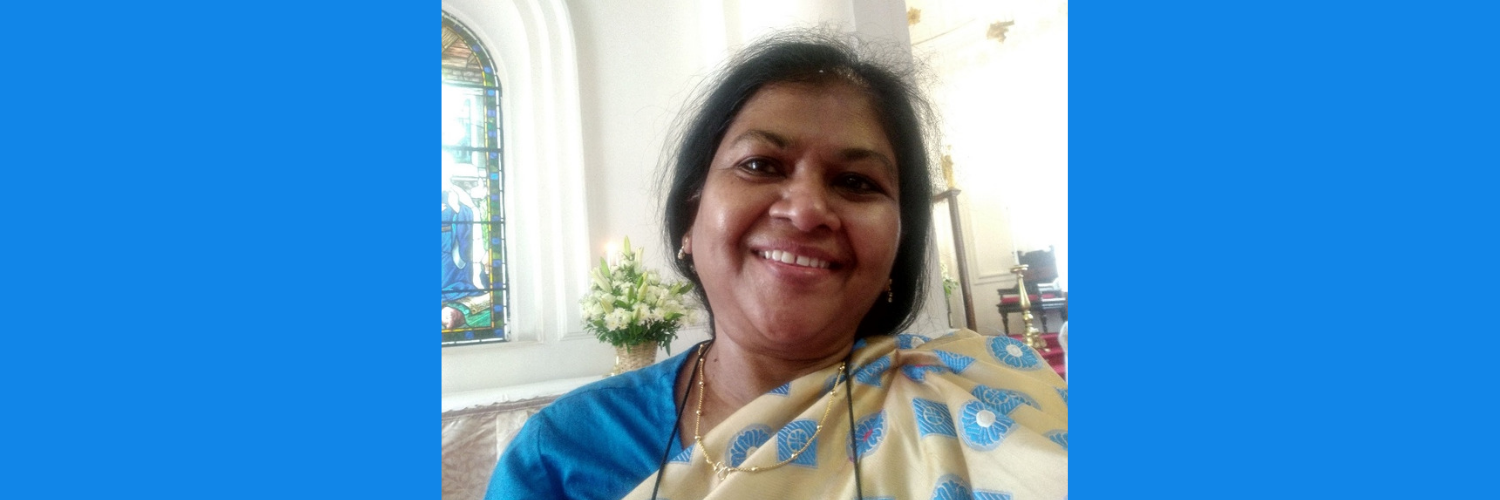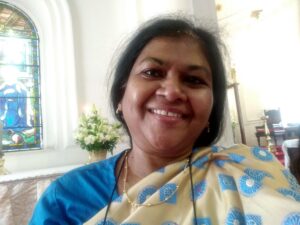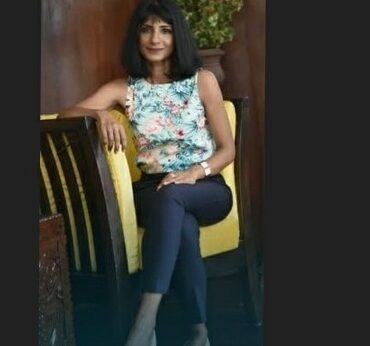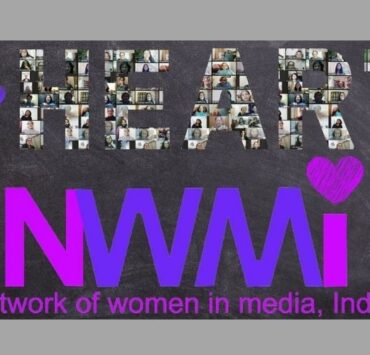
By Sreya Urs

What price your shouts and threats, your ‘dishonouring’ of us women?
Our honour is not so delicate that it can be sullied by your slimy touch or your rapine.
Our courage and our strength come from our veins, from the earth from whence we have sprung.
No matter, you say that you are from head or belly or thighs, we sprang from the earth, the broken ones, being trampled to dust.
Excerpted from the poem ‘Red’, by Cynthia Stephen
NWMI member Cynthia Stephen is a writer, researcher, scholar and public policy advocate and activist whose work on caste and gender is seminal.
Dalit women’s issues were highlighted for the first time at the UN Convention on the Elimination of all Forms of Discrimination Against Women CEDAW in New York , thanks to a chapter she wrote for the NGO report from India for the 2007 session titled ‘CEDAW and Dalit Women’.
Cynthia Akka as she is known, has also been active in both the local government and NGO sectors over the years. She was State Programme Director of Mahila Samakhya Karnataka, an autonomous body set up by the government to work as a bridge between government and NGOs on issues concerning rural women. In 2014 she was a member of the Karnataka Panchayat Raj Act Amendment Committee, whose recommendations included giving gram sabhas more responsibility in the functioning of gram panchayats, and mandatorily setting up separate gram sabhas for women, children and Scheduled Castes and Tribes. She also lobbied (unsuccessfully) for the Bihar model of Nyaya Panchayats in Karnataka. These quasi-judicial bodies have helped make justice more accessible to people, especially women, at the panchayat level in Bihar.
Sreya: When did you first encounter casteism?
Sreya: You trace your education in the evils of the caste system to your early working years. Isn’t it surprising that even the NGO sector is not immune to these biases?
Cynthia: Yes, it is surprising and disappointing. Once, I was asked to apply for the post of editor for a publishing house run by some NGOs – I won’t tell you the name of the institution. I was very excited and submitted my biodata. Once that happened, I saw that the people who had initially been warm and welcoming suddenly turned ice-cold. They didn’t even want to talk to me. I didn’t know why. I realised that they must have discovered that I was a Dalit – I am not sure how they found out, but they did. There was another incident where an NGO asked me to apply for the post of Program Officer. After seeing my biodata, the same thing happened. I thought it was my lack of a Master’s degree. So that was when I got my Master’s degree in Women’s Studies from Alagappa University. But I still came up against the same brick walls.
Every place I have encountered gender and caste discrimination – it’s not a glass ceiling but more a smoked glass partition. They will never let you cross gender and caste identity. Even in a quasi-government organisation, my qualifications were no protection against discrimination. I was seen as a Dalit, a Christian. I initially did not get the senior job because of this bias. Later I did get in, and I had a very interesting and fulfilling (though stressful) experience, but it was sadly truncated as the familiar biases and corruption caused my contract not to be renewed. However, it was a great learning experience; I learnt how caste operates and gets reinforced within government structures.
Sreya: How did these experiences shape your work as an activist, scholar and writer?
Cynthia: At the beginning of 2000, I was starting to realise that the Dalit label was being thrust upon on me. It took me several years to verify that indeed we had Dalit ancestors, because the older generation didn’t like to talk about it. I realised that I had two grandparents who were Dalits and two who were not because our families converted three to four generations ago.
Never having claimed to be Dalit, once I realised I was, I accepted the awakening of my Dalit consciousness with great joy and pride. I was proud of the hard work, struggle and enterprise of my elders. Thanks to the early work I had done in the NGO sector, I had gained a thorough background on multiple aspects of development and the layered struggles of women, the outcastes and the poor. Being multi-lingual, I had conducted gender and development training programmes for women, Dalits, Adivasis and landless farm workers across the country. I trained them in the art of collective bargaining and how to engage with the democratic process.
My background in a hinterland like Bellary meant that I knew how people lived and struggled on extremely low wages. And while I personally may not have faced caste discrimination, since the Christian community in Bellary was so small and not caste conscious, I was aware that it existed among other communities. I learnt from my travels in the villages, during my stints in NGOs, of how bright Dalit boys who topped their 10th standard exams would be found mysteriously drowned in a well during the summer holidays before college opened. Or how Dalit girls with good academic records would be seduced by upper caste boys, get pregnant and then be abandoned by their boyfriends. The objective was to make sure that high-achieving young Dalits would never rise up. I hadn’t yet started writing about these issues in the 1980s but I was aware of them.
While I was working in the NGO sector, a lot of my work was on gender issues. In one of the organisations where I was working, a woman confided in me about the sexual harassment she was facing. I found it deeply disturbing, because the NGO was supposed to be working at the grassroots level for women. I did raise the issue in my report — and earned the eternal wrath of the male bosses!
This was a time when the media rarely covered issues such as these. It was rare to find any public discourse on the topic of workplace harassment. Occasionally, a few local media outlets would carry such stories but the men running the NGOs had a strong network with politicians and the police. This is when my interest in women’s issues really grew – because even in the NGO space where they were supposed to be working towards gender equality and equity, this kind of nonsense was happening. In my life, there have been times when I felt I may not have had the theoretical knowledge to critique experts – the economists, political scientists – but what I have seen on the job has given me an edge they do not have. It was these factors that helped me find my identity as a Dalit feminist, scholar and activist.
Sreya: How effective has the feminist movement in India been in addressing gender issues, including those relating to caste?
Cynthia: I think the change came when Ruth Manorama conceptualised the National Alliance of Women which was different from existing organisations in India which were carrying the banner for women’s rights. Some of them were left-leaning, some were working at the grassroots level. But nearly all were headed by upper caste, privileged urban women.
Why this is problematic is best explained by an incident from the 1990s during a training programme conducted by a prominent gender training resource organisation in Chennai where some eminent feminists were present. I had asked a question about what the feminist position was on the commodification of women’s bodies in the media. One senior feminist (and I still can’t believe she said this) said, “I think it’s a political statement if a woman comes out and starts shedding her clothes.”
I was shocked by her response but then realised that she was clueless about what Indian society is about, about how the male gaze threatens women. She’d been so privileged that she had never understood how women’s bodies are targeted or commodified. My critique even today is the way elite women’s movement leaders have directed the conversation. If a woman feels that she’s making a political statement by shedding her clothes in public, how privileged is she? This is a blind spot for all of us educated, urban, privileged women. Until I learnt what it was that Dalit women and girls go through, I too was unaware of the politics behind the objectification of women’s bodies.
Dalits are regularly punished by having their girls stripped and raped. Can you understand that as a woman? You can’t. You have to accept that identity and go through that kind of pain and humiliation to understand that stripping clothes off [a woman] in public is the crudest form of oppression in our Indian context. And this feminist was clueless about this.
Sreya: That brings me to the question of the appropriation of marginalised voices – how do we tackle this issue?
Cynthia: First you have to shut up and listen. Have you heard my reaction to [the comment that] women taking off their clothes in public is a political statement from anyone else? No. Because, although I have not experienced it, I know our girls in villages have to pay the ultimate price for even collecting water. You think it is not deliberate that access to water is denied to Dalits? Because it is the women and girls who fetch water. So when you cut [Dalits’] access to water, the men have sexual access to Dalit women and girls. The community is systematically humiliated, their existence called into question, their dignity stripped, over something as basic as water.
Sreya: What role has the media played in silencing or side-lining the voices of marginalised women?
Cynthia: We are still facing this. Please go back to the archives – the Khairlanji massacre* happened. The fact is that the media conspired to hide that atrocity and people had to burn the Deccan Queen train before anybody took notice. It took a foreign intern (Sabrina Buckwalter) to cover the massacre. No Indian publication carried the story.
What more proof do you want of the nature of our media, of the nature of our women’s movement? Did one women’s movement person take up the Khairlanji issue? Today, after I have been screaming for 20-30 years, everyone in the women’s movement finally knows that Cynthia is one lone voice in the media and academia who is talking about the marginalisation of Dalit women’s concerns in the media. I mean, look at how the media covers stories on Dalit women’s rapes compared to rapes of women from other castes. Just compare the coverage of the Nirbhaya atrocity with that at Khairlanji.
Sreya: Are newsrooms to blame for not highlighting issues faced by women or marginalised communities?
Cynthia: It’s not about whether there is enough coverage of women’s issues – there is nothing that isn’t a woman’s issue. But is the women’s point of view being given due importance? The answer is ‘No’. Ours is a highly fragmented society, a highly hierarchical society. So, if the media is the voice of the citizen, then is the voice of the general citizen heard? No, it is not. Look at the kind of importance given to something as unimportant as, say, the races. The sports pages will be covered with news about the races, or even cricket. But a story about the killing of a Dalit will get maybe a three- or four-column centimetre story.
Sreya: Is this because of the low representation of women and the marginalised in Indian newsrooms?
Cynthia: Maybe, maybe not. You have worked in newsrooms so you know that there are women at various levels in the media. But don’t you feel that somehow you are supposed to transcend a woman’s point of view when doing your story? The same is true of the marginalised. You are expected to transcend the marginalised point of view, or else you get slotted and boxed into your caste identity.
In public discourse on issues relating to women or the marginalised, there will be a patriarchal, Brahminical voice which tries to justify whatever is happening, or take a patronising tone which minimises the scale of the violence. And you have to expend enormous energy in countering these voices. The superstructure is so strong that it’s extremely hard for us to project an alternative point of view. And if you do, immediately there is an ad hominem response. You are attacked for being either a woman, a Dalit or, in my case, a Christian.
Sreya: What can be done to highlight marginalised communities’ issues?
Cynthia: It’s not only about getting attention for these issues. The question is: who is listening? You must have heard about the famous theory, ‘Can the subaltern speak?’ It always makes me very angry when I think about it because it implies that if a person speaks, they aren’t subaltern, right? So is a person who is dumb a subaltern? But the subaltern has always been speaking, they have been screaming, but no one has been listening.
The media is utterly compromised but the saving grace is the alternative media and the much-maligned Twitter and the much-maligned Facebook. They have provided a platform for public discourse. Maybe it is chaotic but our marginalised voices became prominent only when these technologies came into the picture.
Sreya: That’s interesting – you say that finally, technology has been the answer to amplify the voices of the marginalised?
Cynthia: Yes, this is how my role as a journalist has changed. Almost twice or thrice a week, I am being interviewed. I have been able to put out an amazing amount of material on the electronic media. People from across the world have been reaching out to me. This would never have happened if I had to depend on the mainstream media for a voice. There has been a democratisation of the media thanks to technology.
And today, I think things are marginally better in that the gratuitous, banal sexism of a few decades ago is not as obvious. For 30 years I have had a ringside view of gender relations. It could be worse, but it could also be better.
* In 2006, Surekha Bhaiyyalal Bhotmange, a Scheduled Caste woman, her two sons and her daughter were murdered in Khairlanji, a village in Maharashtra, over a property dispute. Before they were murdered, Surekha and her daughter Priyanka were paraded naked through the village and, according to some reports, gang-raped.




